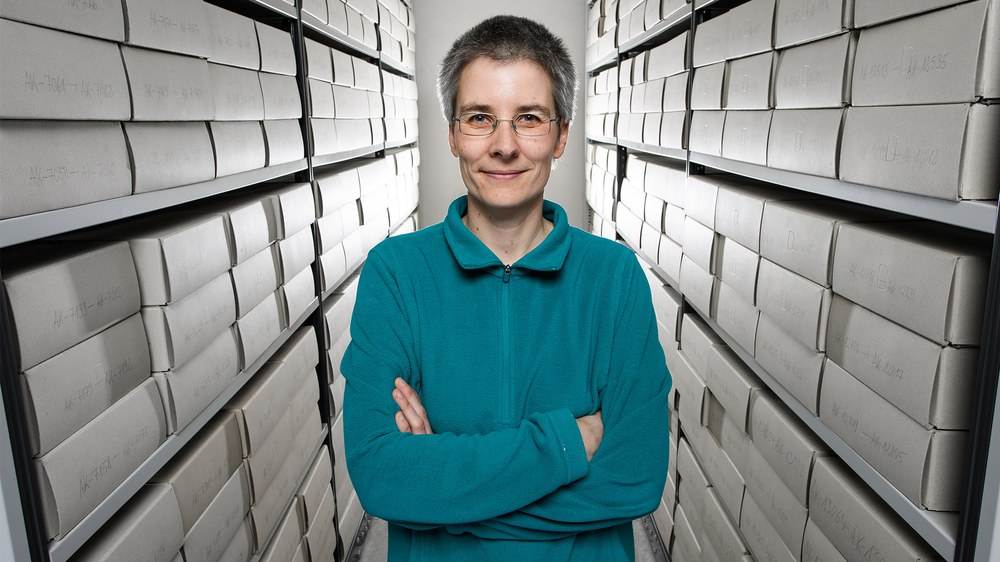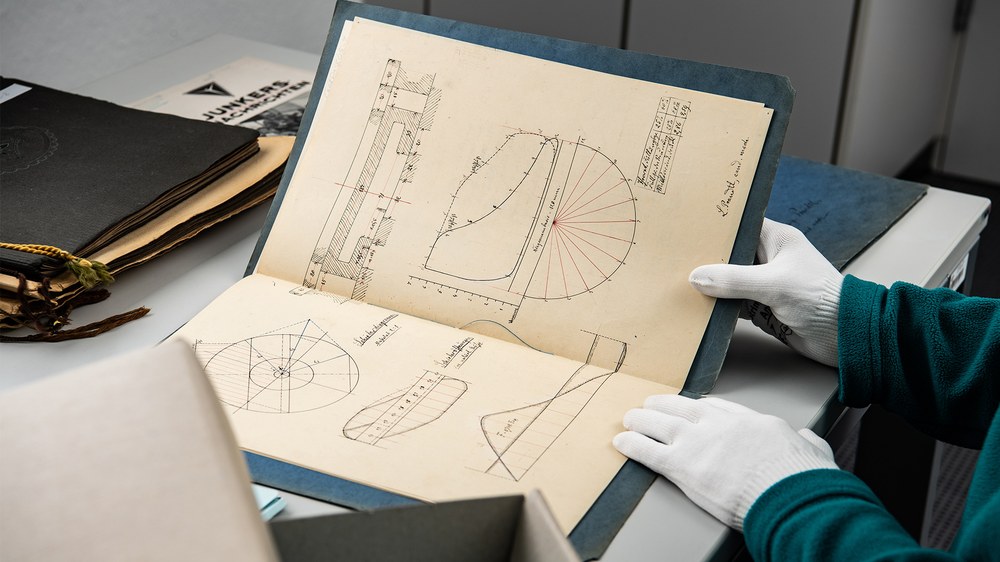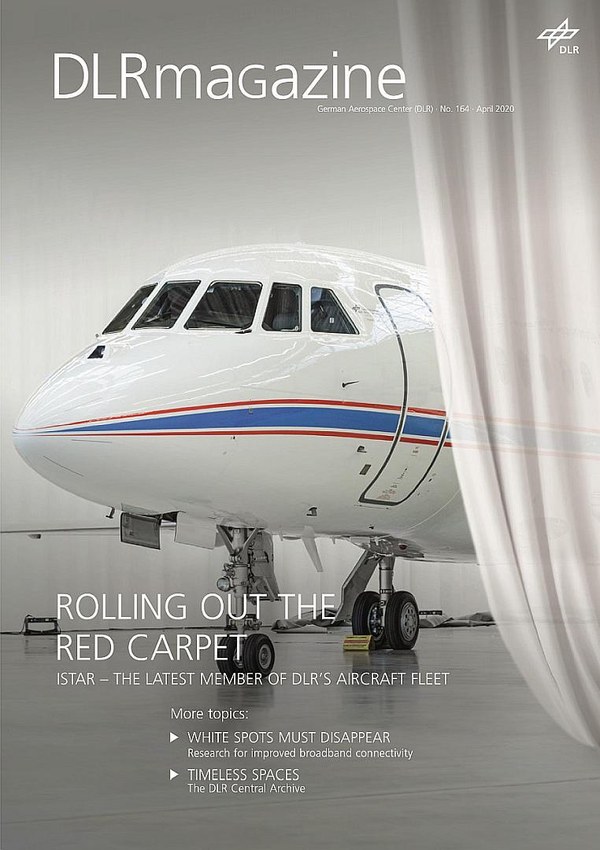DLR's Central Archive safeguards the past, the present and ideas for the future


Preserving history, telling stories, building bridges – the DLR Central Archive safeguards the past, the present and ideas for the future
An ark of life, an archive for Earth
Arche (ἀρχή): The word is both ancient and timeless. In antiquity, philosophers used it to describe the beginning of all things. The Bible refers to the vessel constructed by Noah to provide salvation for animal species as the Ark. Today, derivatives of the word are used to describe repositories for cultural assets: the Voyager Mission, for instance, or the Nebra Ark. The Barbarastollen underground archive in Oberried officially goes by the matter-of-fact title 'Central Storage Site of the Federal Republic of Germany', but it too is often referred to as an ark. Outside of Germany, the Globalt sikkerhetshvelv for frø på Svalbard on Spitzbergen is the world’s largest seed bank – an ark of life, an archive for Earth.
A century of knowledge for tomorrow
Sometimes you have to reach 100 years of age before you are interested in your past. For an institution such as DLR that strives to produce 'knowledge for tomorrow', 100 is no age at all. Indeed, 'tomorrow' is the daily mission for research. As two-time Nobel Prize winner Linus Pauling concisely put it, "Science is fallacy updated". In 2007 DLR celebrated its centenary with festivities in Göttingen, its place of origin. On this occasion, initial discussions were held, and plans made for the establishment of the DLR Central Archive in Göttingen, a city with rich scientific history and producer of 45 Nobel Laureates. Two years later, the management position had to be filled. At that time, Jessika Wichner was completing her PhD in History of Science. She had applied for the role and was on her way to Scotland – one of her adopted homes – when she got the call. Wichner was tasked not only with the role of director, but with helping to establish the archive itself.

It was like she was meant for the role. The daughter of a flight instructor, she grew up around aircraft and aviation enthusiasts near Göttingen. She acquired a deep-set interest in aerospace at home and was already familiar with DLR. Her doctoral thesis was entitled 'The dream of flight – from antiquity to balloon ascents in Great Britain in the late 18th century'. In an interview with the DLRmagazine, she recalls how surprised she had been at the almost complete lack of prior publications in the field. The interdisciplinary nature of the topic appealed to her: combining aviation, history, English and literary studies.
Composure and creativity
A lot changed for Wichner after that call. "It was fantastic to find out that I would soon be at DLR and working on something like this," she says, and her enthusiasm continues to this day. Wichner’s affinity for interdisciplinary work is not the only thing that makes her well suited for the role. As an artistic roller skater, she learned from a young age to concentrate on what is essential. "Competitive sport gave me a certain composure," she says. "Because when you compete and things can come down to a tenth of a second, you can’t simply back out." She also attributes her creativity to sport, as "if doing things one way isn’t working, you have to find another way quickly."
The fine art of omission
In her office, Wichner describes the core tasks of the DLR Central Archive, its inventory and the procedures through which interested parties from both within DLR and beyond can access its material. The archive contains over 50,000 documents and the ratio of external enquiries to those submitted by DLR employees is roughly two to one. One important period is the years following 1969, the year in which the transitional agreement was signed between the Aerodynamics Research Institute (Aerodynamische Versuchsanstalt; AVA), the German Research Institute for Aviation (Deutsche Forschungsanstalt für Luftfahrt; DFL), the German Aviation Tes Institute (DVL) and the German Test and Research Institute for Aviation and Space Flight (Deutsche Forschungs- und Versuchsanstalt für Luft- und Raumfahrt e.V.; DFVLR). With these agreements, DLR as we know it today came into being.

Key documents also include original copies of research papers dating from 1897 by Ludwig Prandtl, considered in a sense to be the founding father of DLR. Today, even the very latest press releases are added to the 'living archive'. Wichner explains that "The criteria we use to determine what requires archiving is decided upon in conjunction with the DLR Executive Board. Of particular importance are documents that contain interesting and meaningful information about the institution." This is where the most difficult questions are discussed. What should be collected? What might be of interest in the future? When it comes to the fine art of omission, it is helpful to establish and follow procedures. Documents that ensure legal certainty, for instance, such as expired patents from the 1930s and 40s and architectural drawings of the DLR sites, should always be archived. Beyond these, it is a matter of preserving frequently requested material and "archiving to the best of your ability," says Wichner.
A distinction is made between the archiving of administrative documents, right down to selected personnel files, in accordance with data protection and personal confidentiality requirements, and research documents. Documents are released according to the regulations of the Federal Archive, which has the longest closing times for documents in Germany. For organisational and historical reasons, documents from the DLR Space Administration and DLR Project Management Agencies are stored in the German Federal Archive rather than DLR’s Central Archive. The over 50,000 records, or 'items', consist of files containing the proceedings of meetings and board resolutions, decisions made by the DLR Senate and the DLR Scientific-Technical Advisory Council, as well as countless other transcripts.
The image material includes 15,000 historic photographic glass plates, primarily from Göttingen and Oberpfaffenhofen, images from DLR Photo Media, which handed over 700 files of negatives in 2019, and much more. "A central registry is essential," says Wichner. "After all, we want to take the burden off employees. What people might see as wastepaper is often a real treasure trove. We’re working against time, against the loss of knowledge." The latter point also applies to older digital material, where the poorer durability of older storage material can cause significant problems. "The IT sector focuses on different, shorter timeframes and expectations than are necessary for an archive." But various external bodies are able to help, such as the Baden-Württemberg Library Service Centre in Konstanz. Archiving can give rise to unforeseen problems: "The increasing use of email to replace older, physical forms of correspondence will result in a knowledge gap for archives," she says. Those who lived through the age of circulars and paper memos will know exactly what she means.
House calls, valuable glimpses into the past and considering the future
As a living archive, the profiling and collection of material rely heavily on the involvement of DLR employees. Archiving is voluntary, but an archive is not simply a place to store superfluous material. "We have to work hard," says Wichner, "to ensure that DLR employees are aware of what we do, think of us and draw our attention to what is worth preserving." The identification of something potentially interesting for the archive results in a business trip which she jokingly refers to as 'our house call'."DLR’s site in Oberpfaffenhofen is one of the main ports of call for such business trips. The site is home to the Department of Scientific Information, headed by Jutta Graf who is responsible for the DLR Central Archive, the DLR Library and the DLR research data manager."
Oberpfaffenhofen remains the most productive DLR site in terms of submissions to the Central Archive. The four employees of the DLR Archive look over requests and are often called to view garages full of old papers or asked to offer professional advice during relocations Keeping the past from becoming forgotten brings a new dimension to the archiving of scientific and technical work. Wichner shares an anecdote about some documents in the archive that came from helicopter researcher Walter Just, who founded the German Helicopter Study Group (Deutsche Studiengemeinschaft Hubschrauber) in 1953, which was later incorporated into the DFL in Braunschweig in 1964. The documents include theses by students that are of interest to engineers today. They contain all sorts of ideas that were not practicable at that time but which could be realised today using modern materials. "That’s just one example," says Wichner, "of how relaying scientific and engineering history can open up potential for the future."
Building bridges for young people

The future belongs to the young. As such, inspiring young people is an important part of archiving work. 'Future Day' (also called 'Girls’ Day / Future Day', including boys in Lower Saxony) offers a good opportunity to do just that. "We are building bridges," says Wichner, "by showing children what we are interested in preserving and how we acquire it. Often, the subject that it concerns will be familiar to them from their schoolwork." She fetches one of the archive’s treasures, an original copy of a letter written in 1935 by the last German Kaiser, Wilhelm II, long after his abdication and from his exile in Doorn, the Netherlands, to Professor Heinrich Koppe in Braunschweig. In it, Wilhelm expresses his gratitude for the scientific work that the Professor had sent him, of which he found "a lecture on the practical experience of lightning strikes in aircraft" particularly interesting. Most intriguingly of all, from our point of view, he adds his autograph – "as a token of my gratitude and appreciation" – majestically signed in purple ink.
A network of ideas
Jessika Wichner writes simply, with a pencil. When asked about her use of graphite, she says that, while it is a coincidence, ballpoint pen ink does indeed fade much faster. This kind of coincidence (which often don’t seem to be coincidences after all) may well be what sets good historians who can run successful archives apart. This archivist still very much enjoys working in timeless spaces where history, stories, people’s lives and the future coexist. "I enjoy every day and always learn something new," says Wichner. "People come together at DLR to develop ideas as part of a network." We are all most welcome to visit the archive and its team of employees. That goes for you, too!

